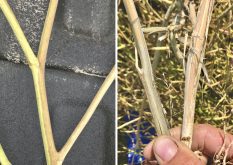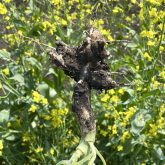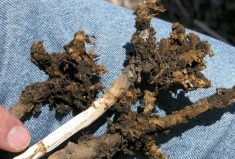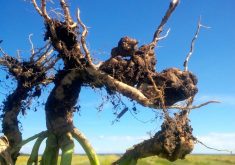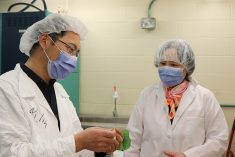When the world’s top clubroot researchers gathered here earlier this month, a hot topic of discussion wasn’t cutting-edge science but an old-fashioned way of controlling a crop infestation — hand-pulling diseased plants.
Once a field is heavily infested with clubroot spores, there’s virtually no economical way to deal with the infestation. But at the International Clubroot Workshop in Edmonton, a group of scientists debated the merits of simply pulling small clubroot-infested patches.
That can be an effective way to prevent heavy infestations because of the way clubroot spores are spread, said Bruce Gossen, a plant pathologist with Agriculture and Agri-Food Canada.

“Because the soil is coming off of our equipment as a main mechanism of movement, it ends up in little patches,” said Gossen. “A single person with a quad could actually go in and pull them out. It would have an enormous impact on the subsequent spore load in that plot.
“Why aren’t we doing that? We just never thought on a per-field basis that that would be manageable at all. We should be doing that.”
Once the infestation reaches a certain size, it’s impossible to pull enough plants.
If about 20 acres of a field are infested, you’ve got a heavy infestation, even if the remainder of the field is relatively free of spores.
Read Also

New crop insurer policy enables easier startup for faba beans
Agriculture Financial Services Corporation updated its normals for faba beans, which may open the door for more Canadian producers to feel comfortable growing the pulse crop in the future.
“You can treat this small 20-acre piece in a completely different way from anything else,” said Gossen. “To me, the other really interesting observation is this whole business of clusters of fields that have similar new pathotypes, these new aggressive pathotypes. What that indicates to me is that the pathotype is spreading out to infested fields.”
Very high spore levels quickly lead to resistant varieties being overcome, so slowing the spread of new pathogens can prevent or delay that scenario.
Gossen has created a recipe, which he calls “the gospel,” for controlling clubroot.
“First, you’ve got to identify the affected area if you’ve got a small infested area,” he said. “Mark out an area that is bigger than that — two times is the absolute minimum — and then you keep track of that so it doesn’t move.”
The initial area should be limed, which raises the pH level of the soil. This will slow clubroot development although “it’s not a silver bullet,” said Gossen.
Fumigation can reduce disease levels and small areas can be dealt with through more extreme measures such as seeding it to grass and packing down the soil or a process called solarization (putting clear plastic over an area to heat the soil and kill the spores).
Even if those methods are effective, those areas can’t be seeded to non-resistant varieties.
“You can only go back in there with clubroot-resistant material,” said Gossen. “If you go back with susceptible material, you will never get all of the spores.”
Because soil is clinging to, and then falling off, machinery is the major cause of clubroot spread; infestations often are found at the entrances to fields. When that occurs, farmers should create a new exit area and a new area for sanitizing equipment.
“You clean up your field and your equipment before you leave it so you don’t drive it to the next field for sure,” said Gossen.





